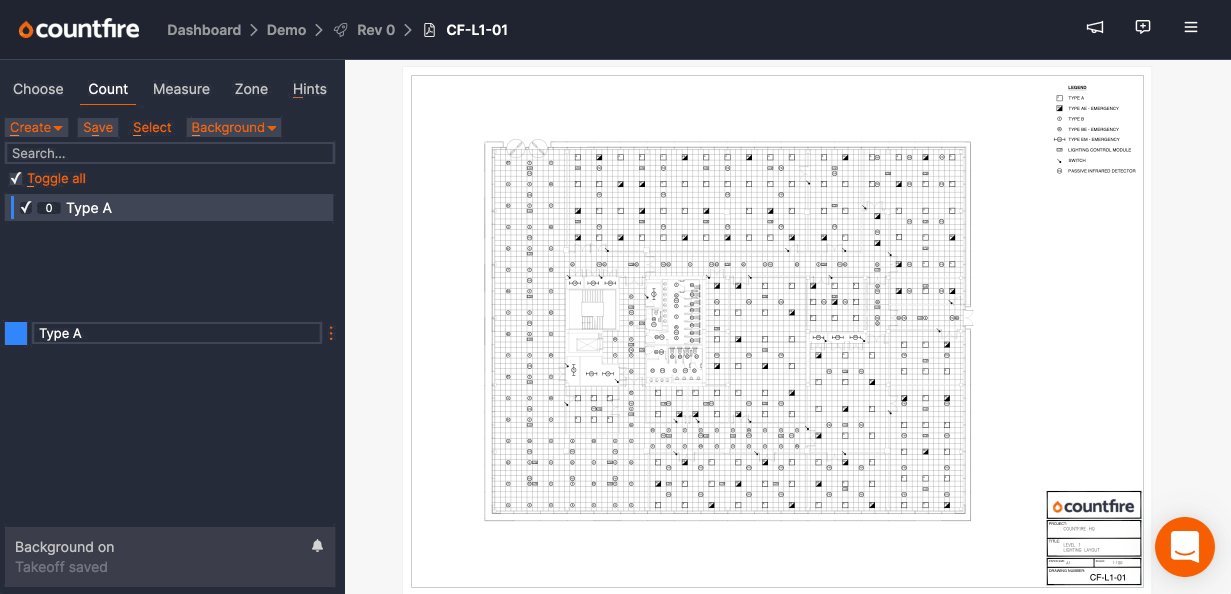
At Countfire many of our team have an estimating background which means we’ve felt firsthand the pain of creating rapid electrical estimates, using a variety of methods. From trusty electrical estimating spreadsheets, to clunky software, the pros and cons of each option is what has allowed us to create a better solution for end-to-end electrical estimating.
One that takes care of estimating in today’s world, using intelligent automation, smart workflows and the flexibility that estimators need in order to react to change.
In this guide we’ll explain what modern electrical estimating software has to offer and how to choose the best electrical estimating software for you.
What is electrical estimating software?
Electrical estimating software is technology that allows you to complete, save and share your estimate for an electrical project. Electrical estimating software is designed for all stages of the estimate, beginning at the takeoff stage allowing you to automatically count symbols, through to adding products, pricing, labour costs and mark-up. Once all of those stages are complete, you receive a finalised total cost and breakdown to submit in response to a tender or project proposal.
While many types of software will be grouped under “electrical estimating software” not all are made equal.
Best types of electrical estimating software
Cloud-based and paperless
Modern-day electrical estimating software is cloud-based so that estimators can work together on estimates in multiplayer mode. Another huge benefit of cloud-based software is that it saves the amount of paper used on traditional estimates.
Printing drawings for manual takeoff can lead to huge costs and effort (not to mention mistakes!). Cloud-based estimating software allows you to upload PDF drawings and automate the counting of symbols, saving hundreds in printing and labour costs, while also increasing accuracy.
True automated takeoff counting
There’s a huge difference between manual and digital takeoff processes, one requiring highlighters and huge reams of paper. The other is using software online to complete the takeoff. However, beyond this there is also a difference between “digital takeoff” software and what we call, “true automated takeoff” software.
Digital takeoff means still manually having to count every symbol, just on your laptop rather than with pen and paper. Whereas with automated takeoff software (like Countfire!) you only need to highlight one symbol, and it will be counted across every drawing within the project in just a few seconds.

The best electrical estimating software has true automated takeoff included and it’s worth spending the time to find this as it’ll make a huge difference to both the time your estimate takes, and its accuracy, further down the line.
Flexible structure
Many estimating packages are rigid in structure, which is why even top estimators are still using Excel to produce estimates. While using Excel to estimate does provide flexibility it also requires a huge amount of time and effort to ensure all of the information is correct and present.
That’s why at Countfire we believe the best electrical estimating software offers flexibility in how you want to work on, and price, your estimate. With the ability to easily make changes, on the fly, to how your estimate is split out, so that you can match your client’s requirements, no matter how, or when, they may change.
End-to-end estimating

Electrical estimating software that provides tools for all parts of the estimate helps to reduce time, and the cost of having to bolt-on other software. From automated takeoff, to being able to save products to re-use them in future estimates, end-to-end estimating software should provide it all.
This type of software also gives increased visibility as all parts of the final estimate live in one place. If a project gets deferred or something changes, the estimator can simply log back in and access all of their work in one place. This also allows for better team collaboration on estimates, simplifying the workflow needed to produce an accurate estimate.
Built-in accuracy checks
The downfall with many estimating platforms is that they provide the ability to estimate, without any safety net built-in. This is why many estimating firms still rely on multiple estimating managers to check over one estimate before it can be submitted.
The best estimating software has built-in accuracy checks to ensure that you’ve covered every angle and that everything, from take-off, to final estimate, to how you mark-up labour and materials, is completely accurate.
How much does electrical estimating software cost?
Electrical estimating software can cost anywhere from a few hundred pounds, up to thousands per user. How many users you have in your company, whether they need full or “view-only” access, and how many projects or drawings you need to estimate can all impact the cost per month.
However, when you add up the cost of manual estimating, everything from the cost of manual takeoff, printing of drawings, to having multiple estimators and estimating managers completing accuracy checks and reviews, the savings electrical estimating software can provide are huge.
Additionally, the time you save on automating your estimating means you can complete more estimates, more quickly, radically increasing your chances of winning more projects each month.
Why Countfire is a great choice for estimating software
With many ex-estimators within our team at Countfire and a close relationship with estimators who help to shape the product we’ve built, we believe that Countfire solves many of the issues estimators face today.
Automatically count symbols across multiple drawings
Being able to auto-count every symbol across your project in just a few seconds provides the type of true automated takeoff that every estimator needs. Simply select a symbol once, give it a name and Countfire will look for this symbol across every drawing you’ve uploaded in the project and count the number of times it appears.
Import from Take-off to Estimate
Forget manually importing the data from your takeoff into an Excel spreadsheet or another estimating tool. Countfire lets you work across the end-to-end estimating process by importing your takeoff into an estimate.

Providing you a full list of the items you have counted, and a way to easily add products and costs to them line by line.
Unrivalled intelligent automation
As well as automated takeoff, Countfire is the first estimating software to use artificial intelligence to learn how to complete your estimates for you, the more you use it. This means that you can import your takeoff counts into your estimate and up to 90% of the pricing work can already be done for you.
Countfire’s intelligent automation learns by how you have previously priced certain products and applies this learning to the items in your current estimate. Meaning that all you need to do is run through the estimate to check over and make small or bulk edits, with minimal manual work required. Taking away the old method of having to build a new product database for every estimate and allowing you to complete an accurate estimate in rapid time.
Easy revision handling
We know firsthand that things change and you have to be able to adapt to this within your estimating process. With Countfire we have built in checks and workflows that allow you to handle revised or new drawings and pricing schedule changes without having to restart the entire process.
This means providing features such as Zones, to allow you to split out one area in your takeoff in response to a pricing schedule change, as well as the ability to recount and reprocess your project, and create reports which change the layout of your estimate to adhere to the right pricing schedule - even after it’s been finalised.
Final thoughts
Our mission is to create the estimating software that’s built for estimators, combining preferred workflows and the latest automation technology to speed up and improve accuracy of every single estimate you create.
Sign-up for a free trial today of Countfire and see how we’re helping estimators to win more work with intelligent, automated estimating software.


